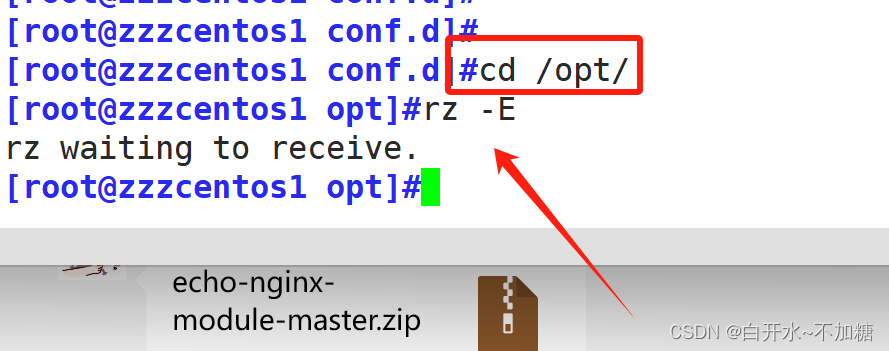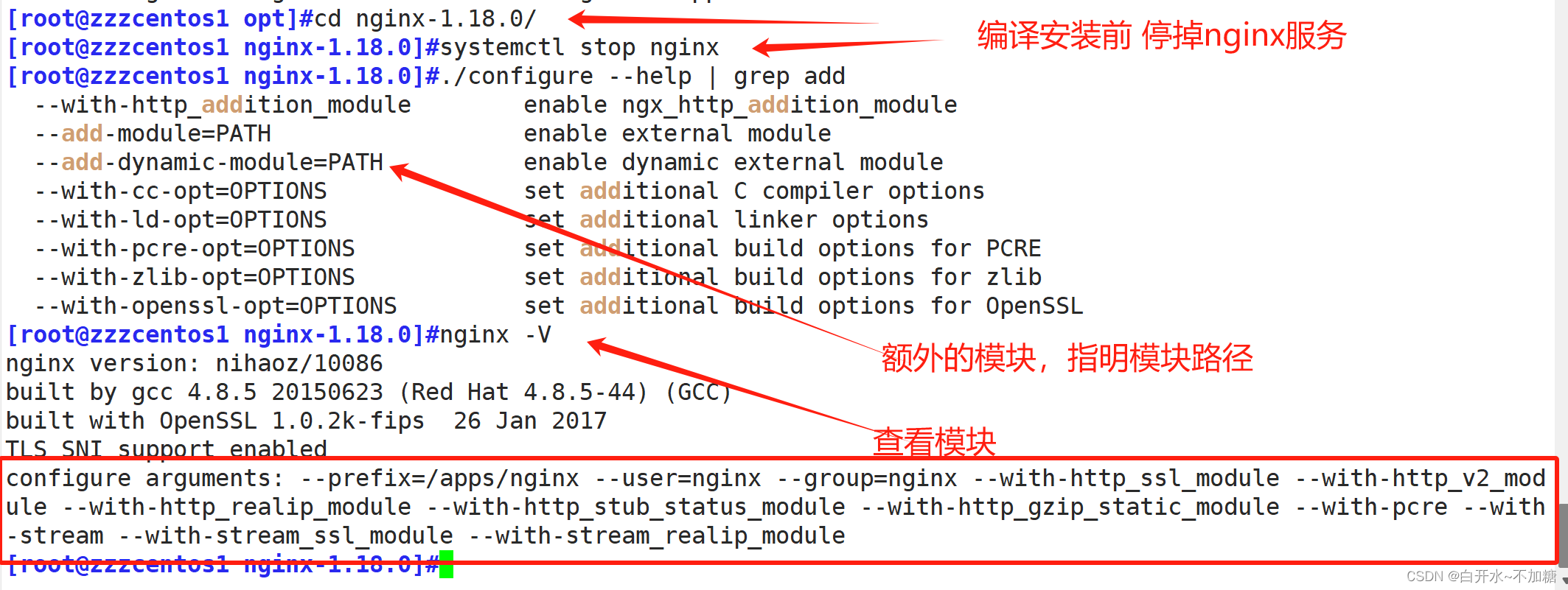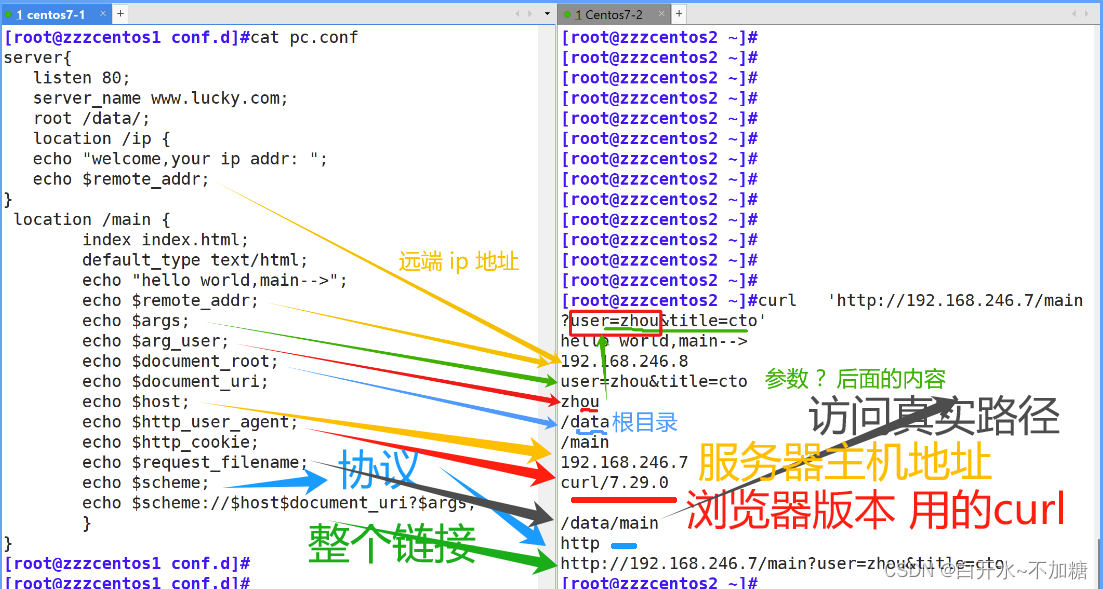一、高级配置
1 .1网页的状态页
基于nginx 模块 ngx_http_stub_status_module 实现,在编译安装nginx的时候需要添加编译参数 --with-http_stub_status_module,否则配置完成之后监测会是提示语法错误注意: 状态页显示的是整个服务器的状态,而非虚拟主机的状态
参考上一篇文章

#配置示例:这样能更安全
location /nginx_status {#stub_status;auth_basic "auth login";auth_basic_user_file /apps/nginx/conf/.htpasswd;allow 192.168.0.0/16;allow 127.0.0.1;deny all;}1.2 Nginx 第三方模块
ehco 模块
开源的echo模块 GitHub - openresty/echo-nginx-module: An Nginx module for bringing the power of "echo", "sleep", "time" and more to Nginx's config file
① 修改子配置文件
[root@zzzcentos1 conf.d]#vim pc.conf
server{listen 80;server_name www.lucky.com;root /data/;location /ip {echo "welcome,your ip addr: ";echo $remote_addr;
}
}




② 依赖nginx编译echo模块
[root@zzzcentos1 conf.d]#cd /opt/
[root@zzzcentos1 opt]#unzip echo-nginx-module-master.zip
[root@zzzcentos1 opt]#cd nginx-1.18.0/
[root@zzzcentos1 nginx-1.18.0]#systemctl stop nginx
[root@zzzcentos1 nginx-1.18.0]#./configure --help | grep add
[root@zzzcentos1 nginx-1.18.0]#nginx -V
[root@zzzcentos1 nginx-1.18.0]#./configure --prefix=/apps/nginx --user=nginx --group=nginx --with-http_ssl_module --with-http_v2_module --with-http_realip_module --with-http_stub_status_module --with-http_gzip_static_module --with-pcre --with-stream --with-stream_ssl_module --with-stream_realip_module --add-module=/opt/echo-nginx-module-master
[root@zzzcentos1 nginx-1.18.0]#make && make install

③ 添加echo模块后检查语法不会报错
[root@zzzcentos1 conf.d]#nginx -t
nginx: the configuration file /apps/nginx/conf/nginx.conf syntax is ok
nginx: configuration file /apps/nginx/conf/nginx.conf test is successful
[root@zzzcentos1 conf.d]#nginx -s reload
nginx: [error] invalid PID number "" in "/apps/nginx/logs/nginx.pid"
[root@zzzcentos1 conf.d]#systemctl start nginx
[root@zzzcentos1 conf.d]#nginx -s reload
④ 访问页面

结合看下

1.3变量
官方文档 http://nginx.org/en/docs/varindex.html
1.3.1常用内置变量
$remote_addr;
#存放了客户端的地址,注意是客户端的公网IP$proxy_add_x_forwarded_for
#此变量表示将客户端IP追加请求报文中X-Forwarded-For首部字段,多个IP之间用逗号分隔,如果请求中没有X-Forwarded-For,就使用$remote_addrthe “X-Forwarded-For” client request header field with the $remote_addr variable appended to it, separated by a comma. If the “X-Forwarded-For” field is not present in the client request header, the $proxy_add_x_forwarded_for variable is equal to the $remote_addr variable.
客户机 代理1 代理2 nginx服务器
$proxy_add_x_forwarded_for: 在代理1 上存的是 客户机的ip
$proxy_add_x_forwarded_for: 在代理2 上存的是 客户机的ip,代理1的ip 用逗号隔开
$proxy_add_x_forwarded_for: nginx 上存的是 客户机的ip,代理1的ip,代理2的ip$args;
#变量中存放了URL中的参数,例如:http://www.kgc.org/main/index.do?id=20190221&partner=search
#返回结果为: id=20190221&partner=search 存放的就是这个select * from table where id=20190221$document_root;
#保存了针对当前资源的请求的系统根目录,例如:/apps/nginx/html$document_uri;
#保存了当前请求中不包含参数的URI,注意是不包含请求的指令,比
如:http://www.kgc.org/main/index.do?id=20190221&partner=search会被定义为/main/index.do
#返回结果为:/main/index.do$host;
#存放了请求的host名称limit_rate 10240;
echo $limit_rate;
#如果nginx服务器使用limit_rate配置了显示网络速率,则会显示,如果没有设置, 则显示0$remote_port;
#客户端请求Nginx服务器时随机打开的端口,这是每个客户端自己的端口$remote_user;
#已经经过Auth Basic Module验证的用户名$request_body_file;
#做反向代理时发给后端服务器的本地资源的名称$request_method;
#请求资源的方式,GET/PUT/DELETE等$request_filename;
#当前请求的资源文件的磁盘路径,由root或alias指令与URI请求生成的文件绝对路径,如:/apps/nginx/html/main/index.html$request_uri; https:// www.baidu.com/main/index.do?id=20190221&partner=search
#包含请求参数的原始URI,不包含主机名,相当于:$document_uri?$args,例如:/main/index.do?id=20190221&partner=search $scheme;
#请求的协议,例如:http,https,ftp等$server_protocol;
#保存了客户端请求资源使用的协议的版本,例如:HTTP/1.0,HTTP/1.1,HTTP/2.0等$server_addr;
#保存了服务器的IP地址$server_name;
#请求的服务器的主机名$server_port; 443 https
#请求的服务器的端口号$http_<name>
#name为任意请求报文首部字段,表示记录请求报文的首部字段
arbitrary request header field; the last part of a variable name is the field name converted to lower case with dashes replaced by underscores
#用下划线代替横线
#示例: echo $http_User_Agent; $http_user_agent;
#客户端浏览器的详细信息$http_cookie;
#客户端的cookie信息$cookie_<name>
#name为任意请求报文首部字部cookie的key名$http_<name>
#name为任意请求报文首部字段,表示记录请求报文的首部字段,ame的对应的首部字段名需要为小写,如果有
横线需要替换为下划线
arbitrary request header field; the last part of a variable name is the field
name converted to lower case with dashes replaced by underscores #用下划线代替横线
#示例:
echo $http_user_agent;
echo $http_host;$sent_http_<name>
#name为响应报文的首部字段,name的对应的首部字段名需要为小写,如果有横线需要替换为下划线,此变量有问题
echo $sent_http_server;$arg_<name>
#此变量存放了URL中的指定参数,name为请求url中指定的参数
#对比 变量 $arg 是全部, 如果 要id 如下
echo $arg_id;
实验:
server{listen 80;server_name www.lucky.com;root /data/;location /ip {echo "welcome,your ip addr: ";echo $remote_addr;
}location /main {index index.html;default_type text/html;echo "hello world,main-->";echo $remote_addr;echo $args;echo $arg_user;echo $document_root;echo $document_uri;echo $host;echo $http_user_agent;echo $http_cookie;echo $request_filename;echo $scheme;echo $scheme://$host$document_uri?$args;}
}① 修改配置文件

②测试验证:

实验结束:

补充下 正向代理 反向代理
正向代理:代理的是客户端
反向代理:代理的是服务端
反向代理:reverse proxy,指的是代理外网用户的请求到内部的指定的服务器,并将数据返回给用户的一种方式,这是用的比较多的一种方式。
总结
$proxy_add_x_forwarded_for 实现ip 透传,记录每一个地址
#此变量表示将客户端IP追加请求报文中X-Forwarded-For首部字段,多个IP之间用逗号分隔,如果请求中没有X-Forwarded-For,就使用$remote_addrthe “X-Forwarded-For” client request header field with the $remote_addr variable appended to it, separated by a comma. If the “X-Forwarded-For” field is not present in the client request header, the $proxy_add_x_forwarded_for variable is equal to the $remote_addr variable.
客户机 代理1 代理2 nginx服务器
$proxy_add_x_forwarded_for: 在代理1 上存的是 客户机的ip
$proxy_add_x_forwarded_for: 在代理2 上存的是 客户机的ip,代理1的ip 用逗号隔开
$proxy_add_x_forwarded_for: nginx 上存的是 客户机的ip,代理1的ip,代理2的ip

$http_user_agent; 客户端浏览器的详细信息
$server_addr; 服务器的IP地址
$scheme; 请求的协议 例如:http,https,ftp等
$http_cookie; 客户端的缓存信息 缓存:cookie和session
$server_protocol; 你使用的协议的版本
$document_root;指明了主站点目录的位置
#保存了针对当前资源的请求的系统根目录,例如:/apps/nginx/html
1.3.2 自定义变量
假如需要自定义变量名称和值,使用指令set $variable value;
语法格式:
Syntax: set $variable value;
Default: —
Context: server, location, if


![SpringCloud Gateway网关 全局过滤器[AntPathMatcher 某些路径url禁止访问] 实现用户鉴权](http://pic.xiahunao.cn/SpringCloud Gateway网关 全局过滤器[AntPathMatcher 某些路径url禁止访问] 实现用户鉴权)



)













